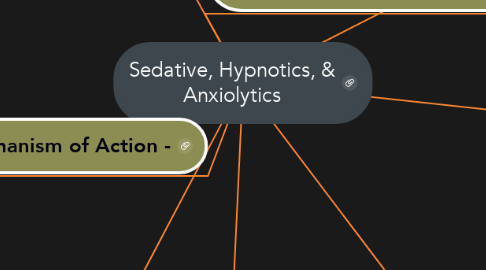
1. The Relevance to Physical Therapy Discusses how you utilize this information in clinical practice.
2. V. General Side-Effects (common to all drug classes)
2.1. Drowsiness, sleepiness, or dizziness
2.2. Blunted Affect
2.3. Increased Appetite
2.4. Next-day Hangover effect
2.5. Anterograde Amnesia
2.6. Highly Addictive - develops Tolerance, Dependency, Withdrawal
2.7. Paradoxical Excitability
3. IV. Drug Classes (categories)
3.1. Barbiturates (-barbitals)
3.1.1. Largely Superseded in Use by Benzodiazepines.
3.1.1.1. Some limited usage is in extreme Insomnia, Seizures not responsive to other agents, Induction of Anesthesia (see anesthetics mind-map), and in tension headaches (added w/Caffeine)
3.1.2. Drug Examples
3.1.2.1. Secobarbital
3.1.2.2. Pentobarbital
3.1.2.3. Phenobarbital
3.1.2.4. Amobarbital - Widely abused (discontinued) by Eli Lilly - not important for you
3.1.3. Adverse Effects of Barbiturates
3.1.3.1. General Side-Effects - similar to those for Benzos - see below:
3.1.3.2. Dangerous Side-effects of Barbiturates (dose-dependent)
3.1.3.2.1. Respiratory Paralysis
3.1.3.2.2. Coma
3.1.3.2.3. Death
3.2. Benzodiazepines ("Benzos" -zepams & -azolams)
3.2.1. Drug Examples
3.2.1.1. Short-Acting (Short 1/2 Life) - ATOM
3.2.1.1.1. Alprazolam
3.2.1.1.2. Triazolam
3.2.1.1.3. Oxazepam
3.2.1.1.4. Midazolam
3.2.1.2. Intermediate-Acting
3.2.1.2.1. Temazepam
3.2.1.2.2. Lormetazepam
3.2.1.3. Long-Acting
3.2.1.3.1. Lorazepam (Ativan)
3.2.1.3.2. Diazepam (Valium)
3.2.1.3.3. Clonazepam (Pintril)
3.2.1.3.4. Chlordiazepoxide
3.2.1.3.5. Tetrazepam
3.2.2. Adverse Effects specific to Benzodiazepines
3.2.2.1. Antidote
3.2.2.1.1. Flumazenil (ONLY DRUG AVAILABLE)
3.2.2.2. General Side-Effects are common to the class - see below (#V)
3.2.2.3. Overdose
3.2.2.3.1. CNS Depression
3.2.2.4. Dependence
3.2.2.4.1. Rebound Phenomenon (also called rebound effect), where the original symptoms for which the drug was being taken come back with a vengeance when it is suddenly stopped, worse than before the drug was started.
3.2.2.4.2. Withdrawal Symptoms (different from original symptoms) that can be life-threatening (when drug suddenly stopped) - particular problem with Benzodiazepines
3.3. Alcohols
3.3.1. Behaves like Barbiturates in Dose-dependent Effects
3.4. Other Benzodiazepine-Like Substances (Z-Drugs - names begin w/"Z")
3.4.1. Zolpidem (Ambien)
3.4.2. Zaleplon
3.4.3. Zopiclone
3.5. Drugs & Classes that don't fit into above Categories
3.5.1. Selective Serotonin Reuptake Inhibitors (SSRIs) - Prototype Drug Venlafaxine (Expand to read Important info >>>)
3.5.1.1. Venlafaxine was Considered Safe initially & stated as such in the book. However, recent evidence that it may not be safe and other safer SSRIs exist
3.5.2. Azapirones (Buspirone)
3.5.2.1. Class of drugs used as anxiolytics, antidepressants, and antipsychotics.
3.5.2.2. They are commonly used as add-ons to other antidepressants, such as selective serotonin reuptake inhibitors (SSRIs)
3.5.3. Melatonin Receptor Agonists
3.5.3.1. Ramelteon (Rozerem)
3.5.3.2. Agomelatine (Valdoxan, Melitor, Thymanax)
3.5.3.3. Tasimelteon (Hetlioz)
3.5.4. Methaqualone (Quaalude)
3.5.5. Ethchlorvynol (Placidyl)
3.5.6. Chloralhydrate (Noctec)
3.5.7. Mebrobamate (Miltown)
4. I. Definition
4.1. Class of drugs that cause a dose-dependent depression of the CNS functions -
5. III. Mechanism of Action -
5.1. Most SHAs work by affecting GABA-ergic transmission...
5.1.1. Increases the inhibition of neuronal excitability
5.1.1.1. Works like GABA - Barbiturates
5.1.1.2. Potentiates GABA - Benzodiazepines
5.2. Melatonin agonists...
5.2.1. - act on hypothalamic melatonin receptors.
6. II. Usage (Indications)
6.1. In Insomniacs - used to induce Sleep (Sedation)
6.2. Hypnotic - Dose-dependent Progression to Unconsciousness - hence used in Anesthesia
6.3. Muscle-Relaxation
6.4. Anti-convulsant - used for seizure management
6.5. Anxiolytic - relieves anxiety
7. VI. Interesting 'Features
7.1. All Drugs in this category have similar effects but Barbiturates & Alcohols have some severe dose-dependent side-effects
7.1.1. With increasing dose, Barbiturates & Alcohols will progress beyond sleep to respiratory paralysis, coma, and death
7.2. Paradoxical Disinhibition
7.3. Drugs from Z-drugs category, e.g. Zolpidem (Ambien) can cause complete loss of memory of events
7.3.1. Sleep walking
7.3.2. Eating
7.3.3. Making Phone Calls
7.3.4. Driving
7.3.5. Sexual events
8. Back to CNS Drugs
9. How to Navigate this Mind Map
9.1. This Mind Map is an extension of the CNS Drugs - hence when done, use the lower floating link to go back to CNS Drugs
9.2. BEGIN - by playing the video attched to the central theme in the middle (take notes).
9.3. Use the numbered progression to navigate this topic
9.4. Expand ALL the Nodes to see ALL the inter-connections.
9.5. A Quizlet link is provided
10. VII. Relevance to Physical Therapy Practice
10.1. General Concepts
10.1.1. Very common class of drugs, so you will notice the side-effects
10.1.2. Highly Addictive
10.1.2.1. Shows Tolerance, Dependence, Withdrawal features
10.1.2.2. Monitor for signs of all of the above. Refer to Substance abuse lecture for explanations to above.
10.1.3. Small-therapeutic Index
10.1.3.1. High risk of death - ~10x of the therapeutic dose has potential to kill the patient.
10.1.3.2. Barbiturates & Alcohols are worst; Benzodiazepines are less so.
10.1.3.3. Newer agents are less addictive but safety is on a drug-by-drug basis
10.2. Effect of Paradoxical Disinhibition
10.2.1. Patient will be talking too much, often without inhibition - This is a sign of impending intoxication
10.2.2. Take steps to mitigate dangerous activities, e.g. driving.
